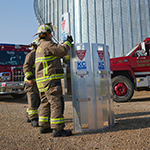Safe storage of ammonium nitrate fertilizer
Review hazards, regulations and best practices to help prevent dangerous incidents.
Safe storage of ammonium nitrate fertilizer
Review hazards, regulations and best practices to help prevent dangerous incidents.
The deadly detonation that occurred on April 17, 2013 at a West, Texas fertilizer plant caused many in the fertilizer and crop-services industry to take a hard look at their own practices regarding the safe handling and storage of ammonium nitrate fertilizer.
This article reviews the hazards associated with fertilizer grade ammonium nitrate, current regulations, lessons learned from the West, Texas incident and Nationwide recommendations to help prevent future incidents.
Hazards
The US Department of Transportation (DOT) classifies fertilizer grade ammonium nitrate (FGAN) as an oxidizer that becomes explosive with added combustibles or organic substances. An oxidizer is a material that releases oxygen or other oxidizing gases, or that can ignite combustible materials when contaminated or exposed to heat. In other words, fertilizer grade ammonium nitrate is not combustible itself, but can contribute to the accelerated burning of combustible materials.
NFPA 400 Hazardous Materials Code considers fertilizer blends with 60% or more ammonium nitrate by weight and higher are to be stored and handled as unblended ammonium nitrate fertilizer (100% FGAN). Also, liquid ammonium nitrate solutions with 70% or higher ammonium nitrate by weight are to be stored and handled as unblended ammonium nitrate (100% FGAN).
At temperatures above 350o F, such involvement in a fire, fertilizer grade ammonium nitrate begins to decompose, liquefy and become molten. At temperatures above 400o F, it produces toxic gases. Heated ammonium nitrate has increased sensitivity to detonation. Detonation may occur if ammonium nitrate is contaminated and heated, heated and confined without adequate ventilation or both.
Regulations
The Occupational Safety and Health Administration (OSHA) maintains standards for the storage of ammonium nitrate, including solid forms of the fertilizer-grade product.1 Learn more in 29 Code of Federal Regulations (CFR) § 1910.109 on the US CFR website.
The National Fire Protection Association (NFPA) 400Hazardous Materials Code applies to the storage, use and handling of ammonium nitrate and other hazardous materials, while chapter 11 of the code deals solely with ammonium nitrate.2 Many state fire codes have adopted NFPA 400. Learn more on the NFPA website.
Other sources of regulation include the DOT, Environmental Protection Agency (EPA) and Department of Homeland Security (DHS) regarding the sales and transfer, transportation and security of ammonium nitrate, as well as reporting information to local emergency responders.
Below are some key requirements included in NFPA 400 for ammonium nitrate storage and handling.
Construction
Building requirements for facilities storing and handling ammonium nitrate include:
- New buildings shall be constructed in accordance with state building code, and shall be of noncombustible construction.
- Newly constructed bins or compartments storing ammonium nitrate should be made of compatible noncombustible materials.
- Building floors shall be of noncombustible construction without open drains, traps, tunnels, pits or pockets.
- Bulk storage structures shall not exceed a height of 40 feet.
- Storage piles of bags, drums or other containers shall comply with limitations regarding pile configurations.
- Buildings should be of good structural integrity and be free of water intrusion, basements or multi-stories.
- Exterior walls on the exposed side of the storage building should be more than 50 feet from combustible buildings or materials, or have fire barrier walls with a minimum two-hour fire resistance rating, or a free-standing fire barrier wall of the same rating.
- Buildings should have mechanical exhaust ventilation or acceptable natural ventilation to help prevent decomposition or confinement of decomposition gases in case of a fire.
- Buildings should have the appropriate NFPA 704 placard posted, including a sign with six-inch red block lettering on a white reflective background that indicates, “DO NOT FIGHT FIRE. EXPLOSION HAZARD.”2
Isolation of ammonium nitrate
Ammonium nitrate shall be isolated in a separate fire barrier concrete room enclosure or in a separate building from the storage of any of the following incompatible materials:
- Organic chemicals
- Compressed flammable gases
- Flammable or combustible liquids
- Chlorides
- Phosphorus
- Any other organic or combustible materials2
Ammonium nitrate storage is prohibited inside the same building as:
- Sulfur
- Finely divided metals
- Explosives or blasting agents
- Materials that may require blasting during processing or handling2
Fire protection
Buildings storing ammonium nitrate shall be equipped with automatic fire sprinkler protection in accordance with NFPA 13 for a design occupancy of Extra Hazard (Group 1).3 Only water-based suppression systems are permitted. Water supplies of a minimum two hours duration shall be provided for hose streams and automatic fire sprinklers.2
Buildings storing ammonium nitrate should be equipped with an approved and supervised fire detection and alarm system.2
Facilities storing more than 1,000 lbs. of ammonium nitrate shall have local audible and visual fire alarm systems to notify occupants and an approved public notification/alert system capable of providing immediate evacuation notice to individuals located within one mile of the facility.2
Portable fire extinguishers shall be provided throughout areas storing and handling ammonium nitrate. Only water-based extinguishers shall be used on initial fires directly involving ammonium nitrate. Dry-chemical extinguishers shall be permitted only for use on initial fires of combustibles that do not involve ammonium nitrate. All other types of extinguishers are prohibited.2
Each facility that handles or stores ammonium nitrate should have an emergency action plan (EAP) and an emergency evacuation plan that meets the requirements of NFPA 400.
Note: These protection requirements apply retroactively to buildings of combustible construction or with combustible contents.
Lessons learned from the West, TX incident
While current regulations serve as good minimum requirements, other issues should also be considered when it comes to risk management and preventing a devastating loss. A review of the fatal detonation incident that occurred in West, Texas can provide some examples.
The US Chemical Safety Board’s preliminary findings published in July of 2013 point out some key factors:
- Ammonium nitrate was stored in a building of wood construction with wood compartments
- Combustible seeds were stored near ammonium nitrate
- The building lacked a sprinkler or other system to detect or suppress a fire
- Approximately 20 minutes passed between fire department notification and detonation
A few conclusions can be reached from these findings. First, current regulation and fire code requirements are not always followed. For various reasons, sometimes people and companies don’t do what they should.
Second, accidents and fires can happen even when current regulations and best practices are followed, whether from an electrical or mechanical malfunction, or other heat or ignition source. As the events in West, Texas demonstrated, under the right conditions, an explosion or detonation can occur when a fire starts and spreads uncontrolled. Many fertilizer plant storage buildings are located in areas served by rural volunteer fire departments with varying response times. Time is of the essence and, even when a full-time fire department serves the location, the response time still may not allow for adequate water application and control of a fully developed fire.
Third, an ammonium nitrate detonation can impact and cause damage more than 2,000 feet away. Many bulk fertilizer plants or other facilities storing ammonium nitrate may be located close to occupied buildings, such as residential housing, businesses, schools, daycares, nursing homes, assisted living complexes, hospitals or neighboring hazardous facilities.
On January 29, 2016, the Chemical Safety Board released new safety video, Dangerously Close: Explosion in West, Texas, detailing report findings and recommendations based on the 2013 fatal West Fertilizer Company explosion and fire.5
Nationwide recommendations and guidelines
Compliance with current regulations
Nationwide recommends customers adhere to the regulations and codes regarding fertilizer grade ammonium nitrate. In addition to being required by law, these measures should be considered as minimum safeguards. Nationwide recommends that additional measures be implemented to minimize the potential for an explosion and mitigate the effects should an explosion occur.
Automatic fire sprinkler protection and fire prevention
Nationwide recommends all buildings storing ammonium nitrate be equipped with automatic fire sprinkler protection because of the possibility of heat exposure in the event of an uncontrolled fire, as well as the minimal amount of time available for emergency personnel to respond. When adequately designed, installed and maintained, these systems have been able to provide reliable fire protection.
Automatic fire sprinkler systems should be installed in accordance with NFPA 13Standard for the Installation of Sprinkler Systems and NFPA 400Hazardous Materials Code .2,3 Give consideration to the condition of buildings storing ammonium nitrate and other fertilizer products by taking into account corrosive environments, unheated buildings and other related issues. The fire protection industry has products and materials for such situations, including dry-pipe and pre-action systems that help prevent freezing or accidental discharge of water, special corrosion-resistant sprinkler heads, pipe coatings/paint and other specialized products suitable for harsh/corrosive environments.
Other fire-prevention measures include:
- Storing ammonium nitrate in dedicated noncombustible buildings with adequate ventilation, which minimize sources of ignition
- Installing fire/heat/smoke detection systems with alarm notification
- Assessing and upgrading electrical systems for condition and/or compliance with the current National Electrical Code (NEC)
- Periodically performing infrared thermography inspections of electrical and mechanical systems and promptly correcting identified problems
- Prohibit hot work activities, smoking, and other ignition sources
- Performing adequate maintenance and daily inspections of mobile equipment for fluid leaks
- Store mobile equipment away from ammonium nitrate storage areas
- Maintain mobile equipment in good working condition
Location of ammonium nitrate storage
An event like the West, Texas explosion can cause fatality, injury and extensive damage to property located hundreds of feet away. Current regulations do not address the issue of siting buildings used to store ammonium nitrate, except for separation from blasting agents and explosives. When considering this, we looked at other industry sources, as well as the West, Texas incident, for guidance regarding the exposure to neighboring buildings.
Factory Mutual Global has published a property loss prevention data sheet, 7-89 Ammonium Nitrate and Mixed Fertilizers Containing Ammonium Nitrate, which recommends locating buildings storing ammonium nitrate away from other important buildings or structures if the pile size is greater than 50 tons. This assumes 10% of the pile would be involved in the detonation up to a maximum pile size of 500 tons, uses a TNT explosion efficiency factor of 33% and calculates damage effects. It indicates minimal detonation hazard for pile sizes of less than 50 tons.6
The Government of Western Australia Department of Mines and Petroleum has published a Code of Practice – Safe Storage of Solid Ammonium Nitrate, which recommends evacuating people (including emergency personnel) to a minimum distance of 2,200 meters (approximately 1-1/2 miles) if a fire involving ammonium nitrate is judged to be out of control or fully engulfing the product. It also includes a table of recommended minimum separation distances to off-site and vulnerable facilities as a function of the quantity of ammonium nitrate stored.7
NFPA 400 Chapter 6 includes Table 6.2.2.3. The American Table of Distances for Storage of Explosives, which lists separation distances from inhabited buildings, public roadways and railways as a function of an equivalent amount of TNT. The distances in this table generally approach 2,000 feet for amounts greater than 20,000 pounds of TNT for un-barricaded storage.2
Last, the West, Texas incident reportedly involved the explosion of approximately 30 tons of a 65-ton pile of ammonium nitrate (approximately 50% of the pile). Fifteen people were killed, including firefighters, civilian helpers, two residents of a nearby apartment complex and one resident of a nearby nursing home. Most of the nearby buildings within a few hundred feet of the explosion were completely destroyed, including an apartment building 600 feet away. Many homes were damaged, and there was significant damage to a nursing home and a school located approximately 750 feet and 1,000 feet away, respectively. Nearly every home or structure within a 1,500 feet radius was damaged or destroyed.
Because of the potential for serious bodily injury and damage to property, consideration should be given to the siting and location of buildings storing ammonium nitrate. This includes not only the proximity to buildings occupied by employees, but particularly neighboring non-owned buildings with occupancies, such as those already discussed in this article.
Nationwide has developed its own recommended minimum separation distances from non-owned neighboring buildings, which are listed in the table below. These distances are partly based on the NFPA 400American Table of Explosives and assumes minimal detonation hazard for pile sizes below 25 tons and a TNT equivalent quantity (weight) factor for ammonium nitrate of 0.33.2
In general, Nationwide recommends storing ammonium nitrate fertilizer piles greater than 25 tons at least 1,500–2,000 feet away from non-owned inhabited buildings or residences. Also, store ammonium nitrate at least 2,000 feet away from places of any assembly or institutional occupancy, including schools, daycare facilities, places of public deliberation or worship, theaters, hospitals, nursing homes, assisted living facilities, jails or other detention facilities, densely populated areas and other high hazard occupancies. Refer to the table below.
In cases where existing storage buildings are in locations that are close to populated areas, consideration should be given to relocating the storage and handling of ammonium nitrate to a more remote location.
Bottom line
By taking the necessary precautions, ammonium nitrate fertilizer can be stored safely. While the numbers of incidents involving this material are relatively few, the effects of an explosion can be devastating to the communities involved.
Complying with current regulations, NFPA codes and standards and Nationwide recommendations can help reduce the chance of a similar catastrophic loss from occurring.
Contact your Nationwide risk management consultant to learn how our team of specialists can help you safely store ammonium nitrate fertilizer.
Nationwide minimum separation distances (in feet) – Ammonium nitrate storage
| Pile Weight (lbs) | Pile Weight (tons) | Adjoining Lot Line or Public Way | High Volume Traffic or Passenger Rail | Inhabited Buildings or Residences | Places of Assembly | Institutional Occupancies |
|---|---|---|---|---|---|---|
| Below 50,000 | Less than 25 | No specific separation except as otherwise indicated in the underwriting guidelines | 2,000 | 2,000 | ||
| 50,000-75,000 | 25-37 | 500 | 1,200 | 1,500 | ||
| 76,000-100,000 | 38-50 | 500 | 1,500 | 2,000 | ||
| Greater than 100,000 | Greater than 50 | 750 | 2,000 | 2,000 | ||
[2] NFPA 400. Hazardous Materials Code.” NFPA.
[3] NFPA 13. “Standard for the Installation of Sprinkler Systems.” NFPA.
[4] “Preliminary Findings of the US Chemical Safety Board from its Investigation of the West Fertilizer Explosion and Fire.>” US Chemical Safety Board. July 2013.
[5] “Chemical Safety Board Releases New Safety Video, “Dangerously Close: Explosion in West, Texas,” Detailing Report Findings and Recommendations on 2013 Fatal West Fertilizer Company Explosion and Fire” US Chemical Safety Board. January 29, 2016.
[6] “Factory Mutual Global. Property Loss Prevention Data Sheet – Ammonium Nitrate and Mixed Fertilizers Containing Ammonium Nitrate.” Factory Mutual Global. April 2013.
[7] “Code of Practice – Safe Storage of Solid Ammonium Nitrate.” Government of Western Australia, Department of Mines and Petroleum. 2013.

 >
>

 >
>
 >
>